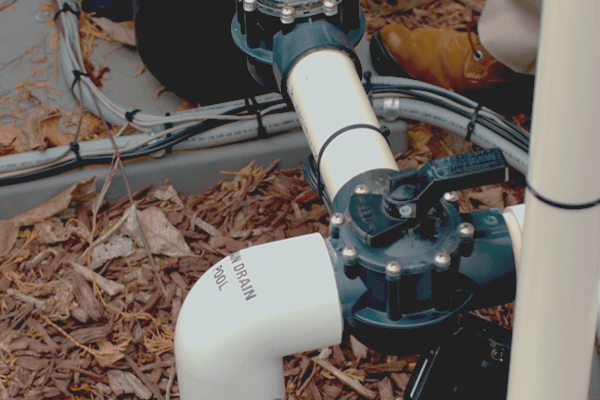Swimming pool valves are some of the most important components in a swimming pool. With a properly functioning valve, it is possible to drain your pool, filter the water, and fill the pool back up again. Because these valves are so important, it’s essential to understand how they work and the many types available in the market. In the sections below, we have discussed how swimming pool valves work, the different types, pool valve materials, and everything in between.

Contents
Understanding the Pool Plumbing System
The pool plumbing system comprises three main components: the suction side, the filter system, and the return side. Let’s first discuss these three components to better understand how pool valves work and where they are installed.
- The suction side: This part of the plumbing system sucks water into the filter system. It comprises skimmers, main drains and suction lines.
- The filter system: This part filters out dirt and debris from the water before it gets back into your pool. It comprises a pre-filter, a pump, filters, a heater and a chlorinator.
- The return side: This part returns clean water to your pool after filtering it. It consists of return lines and jets.
Pool Valve Types
Pool valves are designed to ensure water flows in the right direction throughout the pool plumbing system. They regulate water flow to and from the swimming pool and inside the plumbing system.
Swimming pool valves can be classified into three main types: Ball valves, gate valves and check valves.
Gate Valves
Gate valves are commonly used in several settings and applications. They consist of a valve body with an internal gate that controls fluid flow. In most swimming pools, gate valves are used as shut-off valves, i.e., to completely block or open water flow in the pool supply lines.
Gate valves have low fluid resistance compared to the other types of valves. They also provide superior sealing performance, plus their opening and closing mechanism is faster than most shut-off valves.
Ball Valves
Unlike gate valves, ball valves are quarter-turn valves that are easy to install and maintain. Pool ball valves also have faster closing and opening mechanisms and can be actuated manually using a lever or automatically using an electrical motor or pneumatic actuator. Ball valves used in swimming pools include:
- Multiport ball valves. It attaches to the plumbing system’s filter and serves three main purposes. These are: directing water flow via the filters for cleaning, running pool water backward via the filters to clean and remove debris, and expelling pool water when vacuuming waste. These valves also come with a winter setting that prevents pool water from flowing into the pipes and freezing.
- Diverter ball valves. As the name suggests, these valves divert water flow from one area to another. For instance, they can redirect water from the filter to the heater or the heater to the swimming pool. It can be used as an in-ground or above-ground valve.
- 3-way ball valves. It has three ports and can direct water from port 1 to outlet port 2 or 3, depending on the requirements. Typically, 3-port valves are used for distributing or mixing water.
- Actuated ball valves. These valves use a power source to allow or restrict water flow. An electrical actuator can also be installed on top of a diverter valve and wired into the swimming pool’s control box for redirecting water flow.
Check Valves
Check valves are designed to prevent the backflow of water. In a swimming pool, they are installed near the main drain, automatic chlorinators, pumps, solar heaters, hot tubs and any water feature. There are two main types of water valves: a flapper check valve and a spring check valve. Flapper check valves close automatically once the flow via the check valve stops, while a spring check valve uses a spring to assist with closing the valve.
To ensure optimal operation of check valves, you want to carry on regular maintenance to remove any debris build-up. The typical lifespan of a check valve is around six years. However, you may need to replace worn-out parts after years of continuous use.
Pool Valve Materials
Pool valves come in varying materials, and you always want to pick one that can withstand heated water, chlorine and bromine. Typically, a material such as stainless steel isn’t compatible with bromine, chlorides, HCL or household bleach. However, since pool water has a low chlorine concentration, stainless steel 316 can be used. PVC can also be used as the valve housing material. For seal material, you can choose EPDM or FKM for all the valve types.
